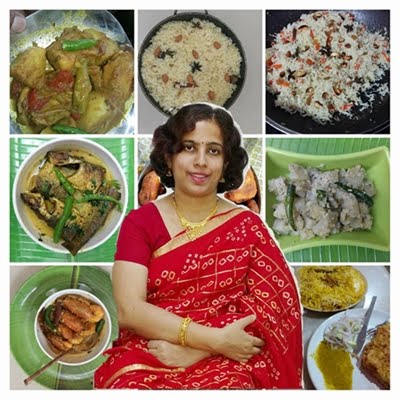When my daughter was born in
CloudNine, a renowned Hospital in Bangalore
The nutritionist over there suggested me to have sea fish at least once a week.
Since then I try to include Pomfret, Mackerel or Sardine in my family’s lunch or dinner
every week. In this blog I have already provided some recipes of Pomfret and Mackerel. Here is one with sardine. It has great health benefits and also the
cheapest among these three.
Health Benefits of Sardine is as follows:
Promote Heart Health
Sardines are rich in numerous nutrients that have been found to support
cardiovascular health. They are one of the most concentrated sources of the
omega-3 fatty acids EPA and DHA, which have been found to lower triglycerides
and cholesterol levels;
Promote Bone Health
Sardines are not only a rich source of bone-building vitamin D, a nutrient
not so readily available in the diet and one that is most often associated with
fortified dairy products.
Promote Optimal Health
For many years, researchers have known that vitamin D, in the form of
calcitriol, participates in the regulation of cell activity. Because cell
cycles play such a key role in the development of cancer, optimal vitamin D
intake may turn out to play an important role in the prevention of various
types of cancer.
Packed with Protein
Sardines are rich in protein, which provides us with amino acids. Our
bodies use amino acids to create new proteins, which serve as the basis for
most of the body's cells and structures. Proteins form the basis of muscles and
connective tissues, antibodies that keep our immune system strong, and
transport proteins that deliver oxygen and nutrients throughout our bodies.
There are many more benefits like helping brain to fight depression,
dementia, ADHD etc. But let’s come to the point and start with this healthy but
delicious dish I made.
Preparation Time: - 15 min
Cooking Time: - 25 min
Servings: - 3 persons
Ingredients:-
- 6 Sardine Fishes
- 1 tsp Black Jeera/ Kalonji / Nigella seeds
- 1 small onion finely chopped
- 3 Green Chilies silted
- 1 tsp ginger paste (optional) – for people who does not like the smell of sea fish
- 1 ½ tbsp Mustard grinded
- 2 tsp Turmeric Powder
- 1 small chopped Tomato
- 1 cup chopped coriander leaves (Cilantro)
- Salt to taste
- 7~8 tbsp Oil – This is a Bengali preparation and hence we need to use mustard oil
Preparation:-
- Wash the fish thoroughly and soak in salt water for 5 min. For any sea fish you need to soak the fish in salt water. This reduces the odor of the sea fish.
- Now pat it dry - add turmeric powder and salt. Marinate for 10 minutes.
- Take 4 tbsp oil in a non-stick kadai /frying pan. Heat the oil in high flame.
- When the bubble settles put the fishes and fry in low flame. Keep aside.
- Pour the rest of the oil in same kadai /frying pan. Heat the oil in high flame.
- Add kalonji and green chili.
- When the jeera splutters add chopped onion. Stir till they turn golden brown.
- Put the ginger paste and stir continuously till it is fried.
- Add chopped tomato, Stir for some time.
- Add a pinch of salt, little bit of water and mustard seeds - grind them to a fine paste.
- Pour the mixture in kadai now. Add turmeric powder and according to your taste you can add some salt
- Stir and mix all the ingredients nicely
- Add 1 cup water and simmer for a while.
- When the gravy starts to boil, add the already fried fish.
- Cook for 8~10 min more.
- Just before finishing add few drops of mustard oil and sprinkle few coriander leaves for garnishing.
Serve this hot with rice.






















































